Counseling Psychology: Applying CBT Theoretical Orientation Analysis
VerifiedAdded on 2022/08/26
|6
|1372
|13
Report
AI Summary
This report provides a comprehensive analysis of the Cognitive Behavioral Therapy (CBT) theoretical orientation in counseling psychology. It begins by defining human nature from a CBT perspective, highlighting the capacity for both rational and irrational thought processes and their impact on behavior. The report then examines human function and dysfunction, explaining how dysfunctional thoughts and behaviors originate and are maintained. The counseling process is evaluated, detailing its goals, which include modifying the way clients think about themselves and bringing about changes in their depression or anxiety levels. The report further applies the graded exposure technique, explaining its effectiveness in reducing anxiety and helping clients cope with difficult situations. The role of relaxation and stress reduction techniques is also discussed. The report uses various references to support its arguments.
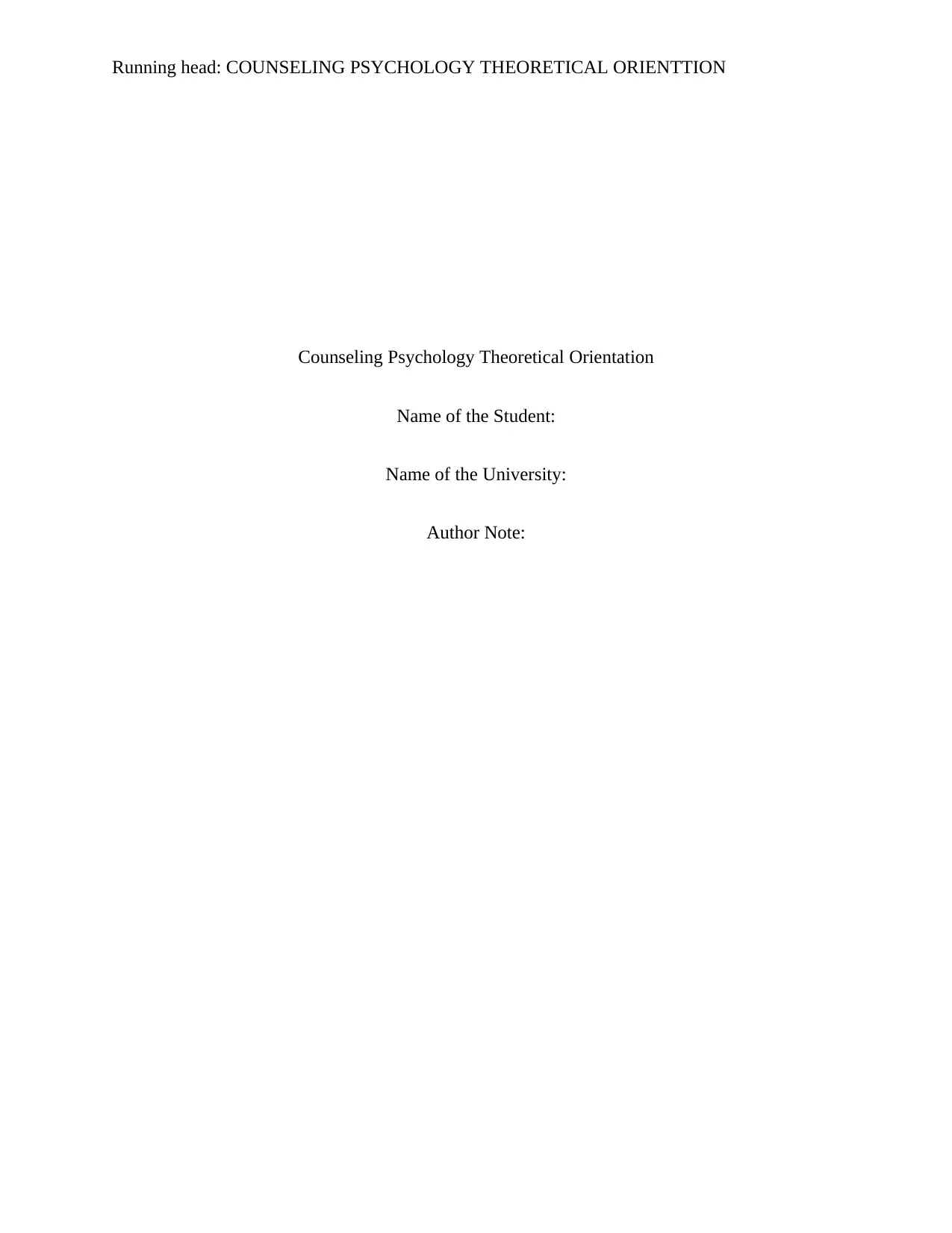
Running head: COUNSELING PSYCHOLOGY THEORETICAL ORIENTTION
Counseling Psychology Theoretical Orientation
Name of the Student:
Name of the University:
Author Note:
Counseling Psychology Theoretical Orientation
Name of the Student:
Name of the University:
Author Note:
Paraphrase This Document
Need a fresh take? Get an instant paraphrase of this document with our AI Paraphraser
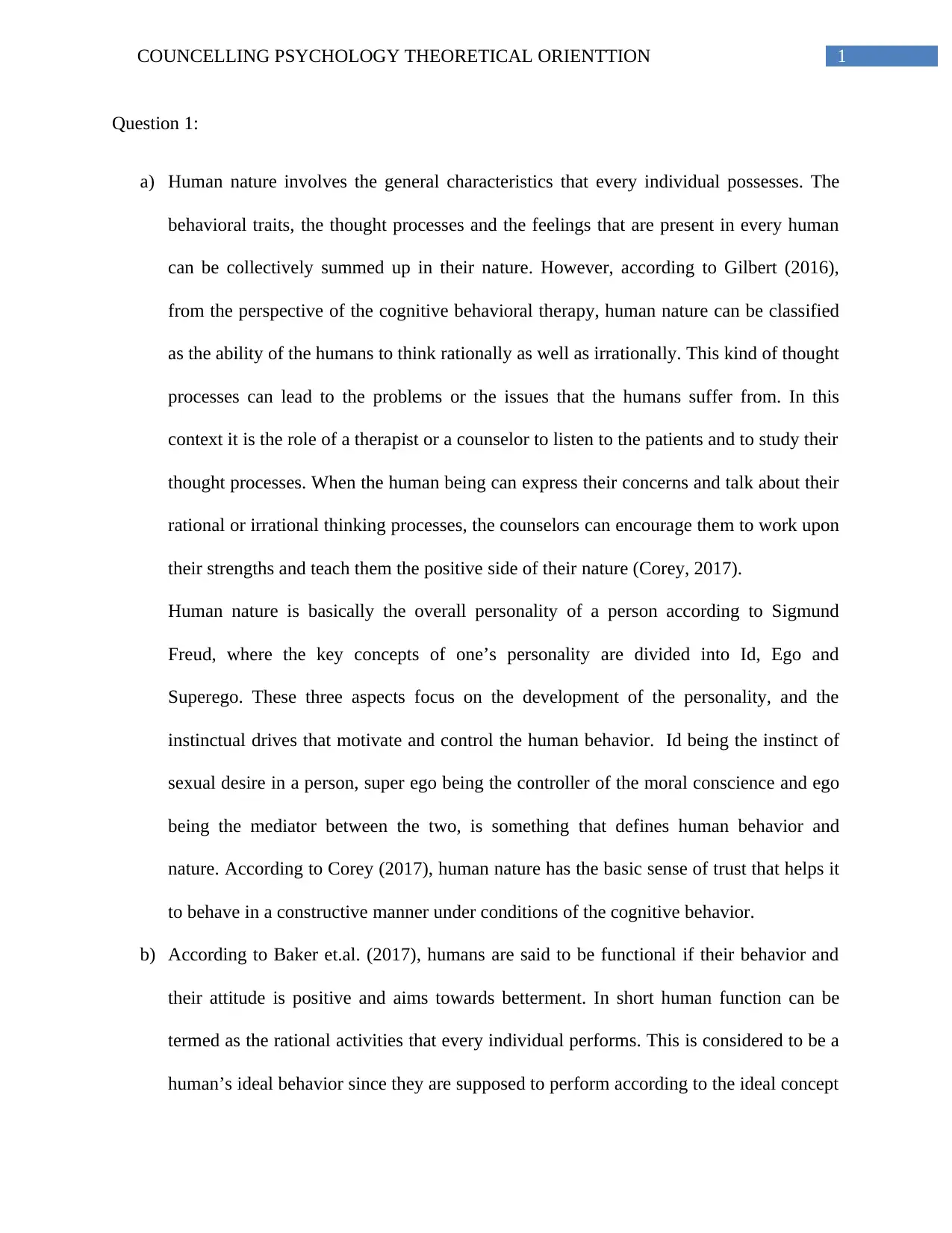
1COUNCELLING PSYCHOLOGY THEORETICAL ORIENTTION
Question 1:
a) Human nature involves the general characteristics that every individual possesses. The
behavioral traits, the thought processes and the feelings that are present in every human
can be collectively summed up in their nature. However, according to Gilbert (2016),
from the perspective of the cognitive behavioral therapy, human nature can be classified
as the ability of the humans to think rationally as well as irrationally. This kind of thought
processes can lead to the problems or the issues that the humans suffer from. In this
context it is the role of a therapist or a counselor to listen to the patients and to study their
thought processes. When the human being can express their concerns and talk about their
rational or irrational thinking processes, the counselors can encourage them to work upon
their strengths and teach them the positive side of their nature (Corey, 2017).
Human nature is basically the overall personality of a person according to Sigmund
Freud, where the key concepts of one’s personality are divided into Id, Ego and
Superego. These three aspects focus on the development of the personality, and the
instinctual drives that motivate and control the human behavior. Id being the instinct of
sexual desire in a person, super ego being the controller of the moral conscience and ego
being the mediator between the two, is something that defines human behavior and
nature. According to Corey (2017), human nature has the basic sense of trust that helps it
to behave in a constructive manner under conditions of the cognitive behavior.
b) According to Baker et.al. (2017), humans are said to be functional if their behavior and
their attitude is positive and aims towards betterment. In short human function can be
termed as the rational activities that every individual performs. This is considered to be a
human’s ideal behavior since they are supposed to perform according to the ideal concept
Question 1:
a) Human nature involves the general characteristics that every individual possesses. The
behavioral traits, the thought processes and the feelings that are present in every human
can be collectively summed up in their nature. However, according to Gilbert (2016),
from the perspective of the cognitive behavioral therapy, human nature can be classified
as the ability of the humans to think rationally as well as irrationally. This kind of thought
processes can lead to the problems or the issues that the humans suffer from. In this
context it is the role of a therapist or a counselor to listen to the patients and to study their
thought processes. When the human being can express their concerns and talk about their
rational or irrational thinking processes, the counselors can encourage them to work upon
their strengths and teach them the positive side of their nature (Corey, 2017).
Human nature is basically the overall personality of a person according to Sigmund
Freud, where the key concepts of one’s personality are divided into Id, Ego and
Superego. These three aspects focus on the development of the personality, and the
instinctual drives that motivate and control the human behavior. Id being the instinct of
sexual desire in a person, super ego being the controller of the moral conscience and ego
being the mediator between the two, is something that defines human behavior and
nature. According to Corey (2017), human nature has the basic sense of trust that helps it
to behave in a constructive manner under conditions of the cognitive behavior.
b) According to Baker et.al. (2017), humans are said to be functional if their behavior and
their attitude is positive and aims towards betterment. In short human function can be
termed as the rational activities that every individual performs. This is considered to be a
human’s ideal behavior since they are supposed to perform according to the ideal concept
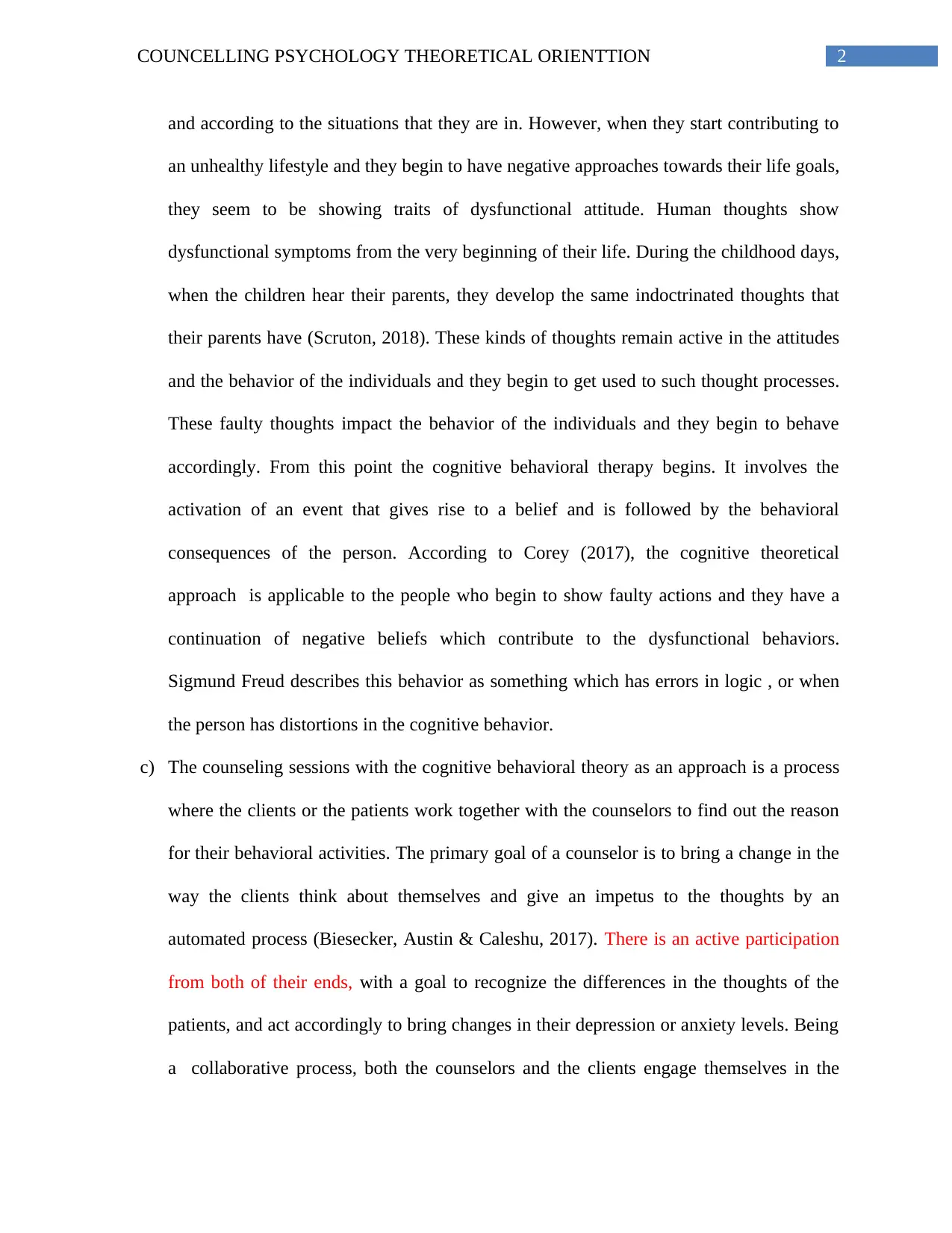
2COUNCELLING PSYCHOLOGY THEORETICAL ORIENTTION
and according to the situations that they are in. However, when they start contributing to
an unhealthy lifestyle and they begin to have negative approaches towards their life goals,
they seem to be showing traits of dysfunctional attitude. Human thoughts show
dysfunctional symptoms from the very beginning of their life. During the childhood days,
when the children hear their parents, they develop the same indoctrinated thoughts that
their parents have (Scruton, 2018). These kinds of thoughts remain active in the attitudes
and the behavior of the individuals and they begin to get used to such thought processes.
These faulty thoughts impact the behavior of the individuals and they begin to behave
accordingly. From this point the cognitive behavioral therapy begins. It involves the
activation of an event that gives rise to a belief and is followed by the behavioral
consequences of the person. According to Corey (2017), the cognitive theoretical
approach is applicable to the people who begin to show faulty actions and they have a
continuation of negative beliefs which contribute to the dysfunctional behaviors.
Sigmund Freud describes this behavior as something which has errors in logic , or when
the person has distortions in the cognitive behavior.
c) The counseling sessions with the cognitive behavioral theory as an approach is a process
where the clients or the patients work together with the counselors to find out the reason
for their behavioral activities. The primary goal of a counselor is to bring a change in the
way the clients think about themselves and give an impetus to the thoughts by an
automated process (Biesecker, Austin & Caleshu, 2017). There is an active participation
from both of their ends, with a goal to recognize the differences in the thoughts of the
patients, and act accordingly to bring changes in their depression or anxiety levels. Being
a collaborative process, both the counselors and the clients engage themselves in the
and according to the situations that they are in. However, when they start contributing to
an unhealthy lifestyle and they begin to have negative approaches towards their life goals,
they seem to be showing traits of dysfunctional attitude. Human thoughts show
dysfunctional symptoms from the very beginning of their life. During the childhood days,
when the children hear their parents, they develop the same indoctrinated thoughts that
their parents have (Scruton, 2018). These kinds of thoughts remain active in the attitudes
and the behavior of the individuals and they begin to get used to such thought processes.
These faulty thoughts impact the behavior of the individuals and they begin to behave
accordingly. From this point the cognitive behavioral therapy begins. It involves the
activation of an event that gives rise to a belief and is followed by the behavioral
consequences of the person. According to Corey (2017), the cognitive theoretical
approach is applicable to the people who begin to show faulty actions and they have a
continuation of negative beliefs which contribute to the dysfunctional behaviors.
Sigmund Freud describes this behavior as something which has errors in logic , or when
the person has distortions in the cognitive behavior.
c) The counseling sessions with the cognitive behavioral theory as an approach is a process
where the clients or the patients work together with the counselors to find out the reason
for their behavioral activities. The primary goal of a counselor is to bring a change in the
way the clients think about themselves and give an impetus to the thoughts by an
automated process (Biesecker, Austin & Caleshu, 2017). There is an active participation
from both of their ends, with a goal to recognize the differences in the thoughts of the
patients, and act accordingly to bring changes in their depression or anxiety levels. Being
a collaborative process, both the counselors and the clients engage themselves in the
⊘ This is a preview!⊘
Do you want full access?
Subscribe today to unlock all pages.

Trusted by 1+ million students worldwide
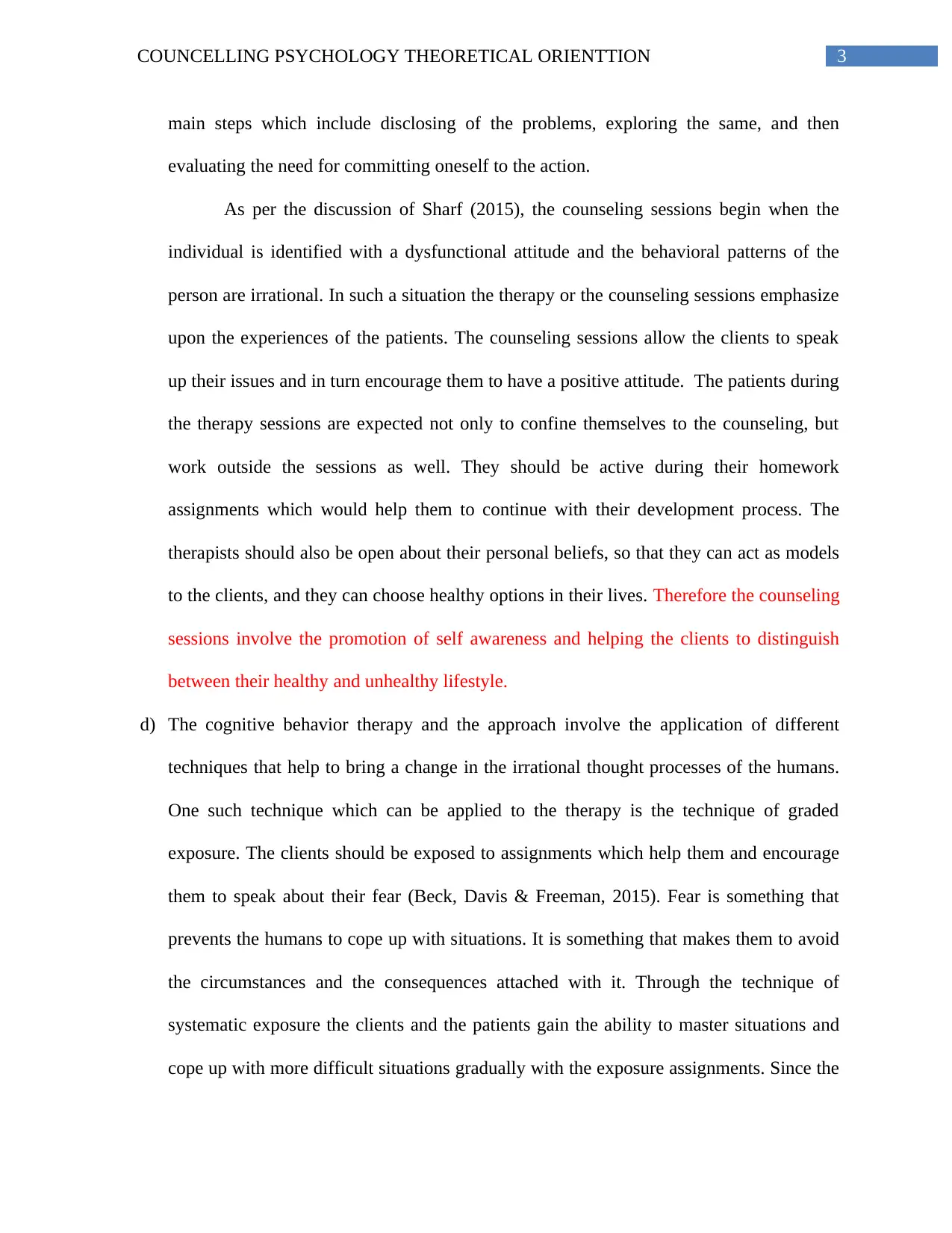
3COUNCELLING PSYCHOLOGY THEORETICAL ORIENTTION
main steps which include disclosing of the problems, exploring the same, and then
evaluating the need for committing oneself to the action.
As per the discussion of Sharf (2015), the counseling sessions begin when the
individual is identified with a dysfunctional attitude and the behavioral patterns of the
person are irrational. In such a situation the therapy or the counseling sessions emphasize
upon the experiences of the patients. The counseling sessions allow the clients to speak
up their issues and in turn encourage them to have a positive attitude. The patients during
the therapy sessions are expected not only to confine themselves to the counseling, but
work outside the sessions as well. They should be active during their homework
assignments which would help them to continue with their development process. The
therapists should also be open about their personal beliefs, so that they can act as models
to the clients, and they can choose healthy options in their lives. Therefore the counseling
sessions involve the promotion of self awareness and helping the clients to distinguish
between their healthy and unhealthy lifestyle.
d) The cognitive behavior therapy and the approach involve the application of different
techniques that help to bring a change in the irrational thought processes of the humans.
One such technique which can be applied to the therapy is the technique of graded
exposure. The clients should be exposed to assignments which help them and encourage
them to speak about their fear (Beck, Davis & Freeman, 2015). Fear is something that
prevents the humans to cope up with situations. It is something that makes them to avoid
the circumstances and the consequences attached with it. Through the technique of
systematic exposure the clients and the patients gain the ability to master situations and
cope up with more difficult situations gradually with the exposure assignments. Since the
main steps which include disclosing of the problems, exploring the same, and then
evaluating the need for committing oneself to the action.
As per the discussion of Sharf (2015), the counseling sessions begin when the
individual is identified with a dysfunctional attitude and the behavioral patterns of the
person are irrational. In such a situation the therapy or the counseling sessions emphasize
upon the experiences of the patients. The counseling sessions allow the clients to speak
up their issues and in turn encourage them to have a positive attitude. The patients during
the therapy sessions are expected not only to confine themselves to the counseling, but
work outside the sessions as well. They should be active during their homework
assignments which would help them to continue with their development process. The
therapists should also be open about their personal beliefs, so that they can act as models
to the clients, and they can choose healthy options in their lives. Therefore the counseling
sessions involve the promotion of self awareness and helping the clients to distinguish
between their healthy and unhealthy lifestyle.
d) The cognitive behavior therapy and the approach involve the application of different
techniques that help to bring a change in the irrational thought processes of the humans.
One such technique which can be applied to the therapy is the technique of graded
exposure. The clients should be exposed to assignments which help them and encourage
them to speak about their fear (Beck, Davis & Freeman, 2015). Fear is something that
prevents the humans to cope up with situations. It is something that makes them to avoid
the circumstances and the consequences attached with it. Through the technique of
systematic exposure the clients and the patients gain the ability to master situations and
cope up with more difficult situations gradually with the exposure assignments. Since the
Paraphrase This Document
Need a fresh take? Get an instant paraphrase of this document with our AI Paraphraser
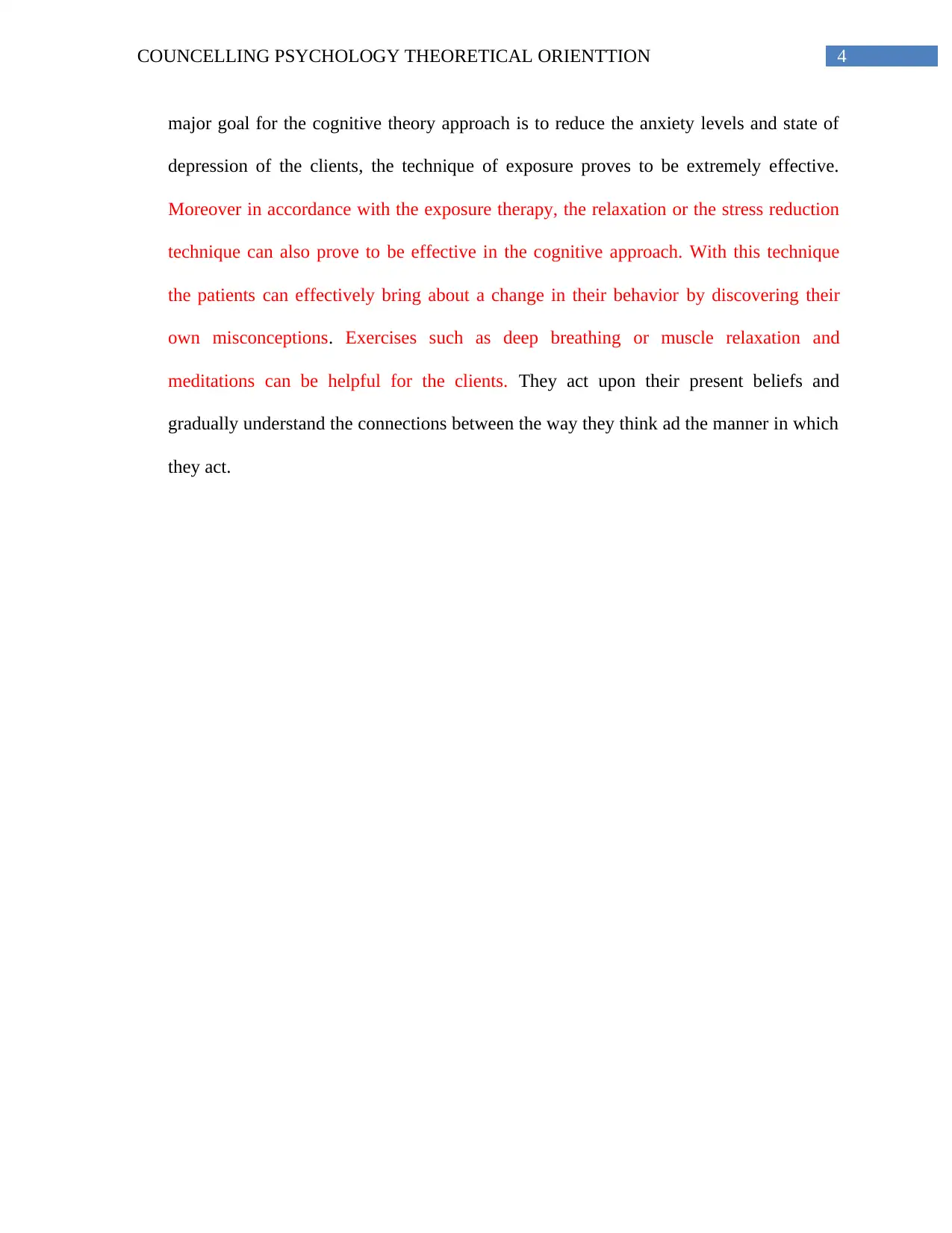
4COUNCELLING PSYCHOLOGY THEORETICAL ORIENTTION
major goal for the cognitive theory approach is to reduce the anxiety levels and state of
depression of the clients, the technique of exposure proves to be extremely effective.
Moreover in accordance with the exposure therapy, the relaxation or the stress reduction
technique can also prove to be effective in the cognitive approach. With this technique
the patients can effectively bring about a change in their behavior by discovering their
own misconceptions. Exercises such as deep breathing or muscle relaxation and
meditations can be helpful for the clients. They act upon their present beliefs and
gradually understand the connections between the way they think ad the manner in which
they act.
major goal for the cognitive theory approach is to reduce the anxiety levels and state of
depression of the clients, the technique of exposure proves to be extremely effective.
Moreover in accordance with the exposure therapy, the relaxation or the stress reduction
technique can also prove to be effective in the cognitive approach. With this technique
the patients can effectively bring about a change in their behavior by discovering their
own misconceptions. Exercises such as deep breathing or muscle relaxation and
meditations can be helpful for the clients. They act upon their present beliefs and
gradually understand the connections between the way they think ad the manner in which
they act.
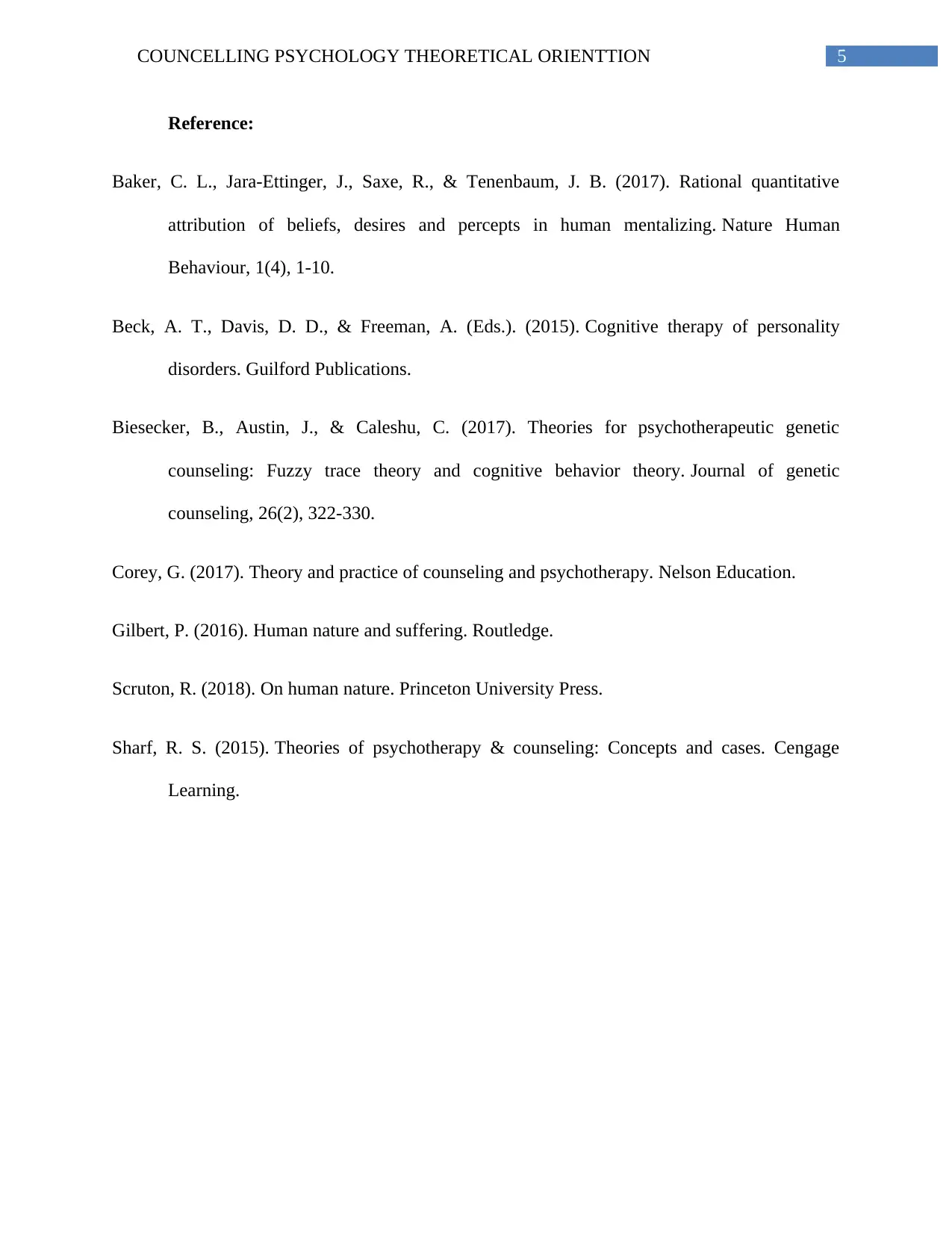
5COUNCELLING PSYCHOLOGY THEORETICAL ORIENTTION
Reference:
Baker, C. L., Jara-Ettinger, J., Saxe, R., & Tenenbaum, J. B. (2017). Rational quantitative
attribution of beliefs, desires and percepts in human mentalizing. Nature Human
Behaviour, 1(4), 1-10.
Beck, A. T., Davis, D. D., & Freeman, A. (Eds.). (2015). Cognitive therapy of personality
disorders. Guilford Publications.
Biesecker, B., Austin, J., & Caleshu, C. (2017). Theories for psychotherapeutic genetic
counseling: Fuzzy trace theory and cognitive behavior theory. Journal of genetic
counseling, 26(2), 322-330.
Corey, G. (2017). Theory and practice of counseling and psychotherapy. Nelson Education.
Gilbert, P. (2016). Human nature and suffering. Routledge.
Scruton, R. (2018). On human nature. Princeton University Press.
Sharf, R. S. (2015). Theories of psychotherapy & counseling: Concepts and cases. Cengage
Learning.
Reference:
Baker, C. L., Jara-Ettinger, J., Saxe, R., & Tenenbaum, J. B. (2017). Rational quantitative
attribution of beliefs, desires and percepts in human mentalizing. Nature Human
Behaviour, 1(4), 1-10.
Beck, A. T., Davis, D. D., & Freeman, A. (Eds.). (2015). Cognitive therapy of personality
disorders. Guilford Publications.
Biesecker, B., Austin, J., & Caleshu, C. (2017). Theories for psychotherapeutic genetic
counseling: Fuzzy trace theory and cognitive behavior theory. Journal of genetic
counseling, 26(2), 322-330.
Corey, G. (2017). Theory and practice of counseling and psychotherapy. Nelson Education.
Gilbert, P. (2016). Human nature and suffering. Routledge.
Scruton, R. (2018). On human nature. Princeton University Press.
Sharf, R. S. (2015). Theories of psychotherapy & counseling: Concepts and cases. Cengage
Learning.
⊘ This is a preview!⊘
Do you want full access?
Subscribe today to unlock all pages.

Trusted by 1+ million students worldwide
1 out of 6
Related Documents
Your All-in-One AI-Powered Toolkit for Academic Success.
+13062052269
info@desklib.com
Available 24*7 on WhatsApp / Email
![[object Object]](/_next/static/media/star-bottom.7253800d.svg)
Unlock your academic potential
Copyright © 2020–2025 A2Z Services. All Rights Reserved. Developed and managed by ZUCOL.




